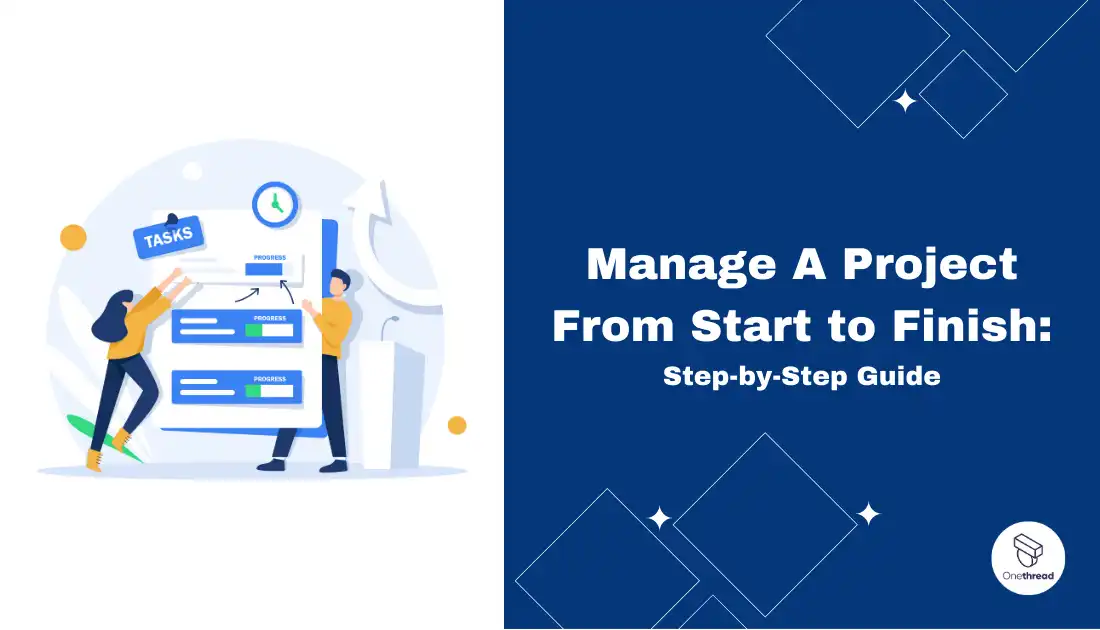Feeling overwhelmed by the prospect of managing a project? You’re not alone. Juggling tasks, deadlines, and expectations can feel like a never-ending tightrope walk. But fear not! This comprehensive guide is your roadmap to navigating the complexities of project management and achieving success.
We’ll break down the entire process into bite-sized, actionable steps, from the initial brainstorming to the final celebratory toast. We’ll delve into the five crucial stages—initiation, planning, execution, monitoring, and closure—equipping you with the knowledge and tools to tackle each one with confidence.
Whether you’re a seasoned pro or a beginner, this guide has something for everyone.
Ready to transform your project management game? Dive into the guide now!
Understanding Project Management: What Is It?
Project management is the process of planning, organizing, and managing resources to complete a project successfully on time and within budget.
To elaborate further, project management involves coordinating people, equipment, materials, budgets, and schedules to achieve a specific goal. It starts with defining project objectives and deliverables and then planning all the tasks, resources, and timelines required.
A project manager oversees the execution, monitors progress, and adjusts plans as needed. Effective project management is key to delivering projects on time and within budget.
Critical project management responsibilities include:
- Scoping projects
- Creating schedules and budgets
- Managing teams and stakeholders
- Assessing risks
- Overcoming obstacles, and
- Closing projects.
Project managers utilize various processes, tools, and techniques to accomplish these tasks.
With good project management, organizations can execute strategic initiatives that support business objectives.
Why Is It Important?
Here are the main reasons why project management is so important:
- It helps accomplish goals and objectives: Careful project planning and management provide the roadmap for how to get tasks completed efficiently to reach the end goals. Without it, teams lack direction and are far more likely to go over budget or past deadlines in trying to figure out what to do.
- It increases transparency: With a defined project scope and plan, everyone understands what needs to be achieved. Progress tracking also ensures teams know where things stand at all times instead of being left in the dark.
- It facilitates collaboration: Breaking projects down into tasks and subtasks makes it easy to see who is responsible for what pieces. Team members can work independently but still come together effectively on interconnected work.
- It drives innovation: Completing projects, especially complex or large-scale ones, requires trying new approaches, tools, and workflows. Learning to master project management means continuously adopting innovations that enhance outcomes.
- It controls costs: Careful budget allocation, resource planning, and expense tracking ensure no money is wasted. Adaptability in project management also allows for swift responses to financial overages to minimize costs.
Project management is important because it oversees and drives execution in such a detailed and transparent way that organizations can meet goals on time and on budget. Without disciplined project management, teams operate blindly and wastefully, making it nearly impossible to accomplish difficult objectives. That ability to strategize and deliver is invaluable for any company.
How to Manage A Project From Start to Finish: A Step-by-Step Guide
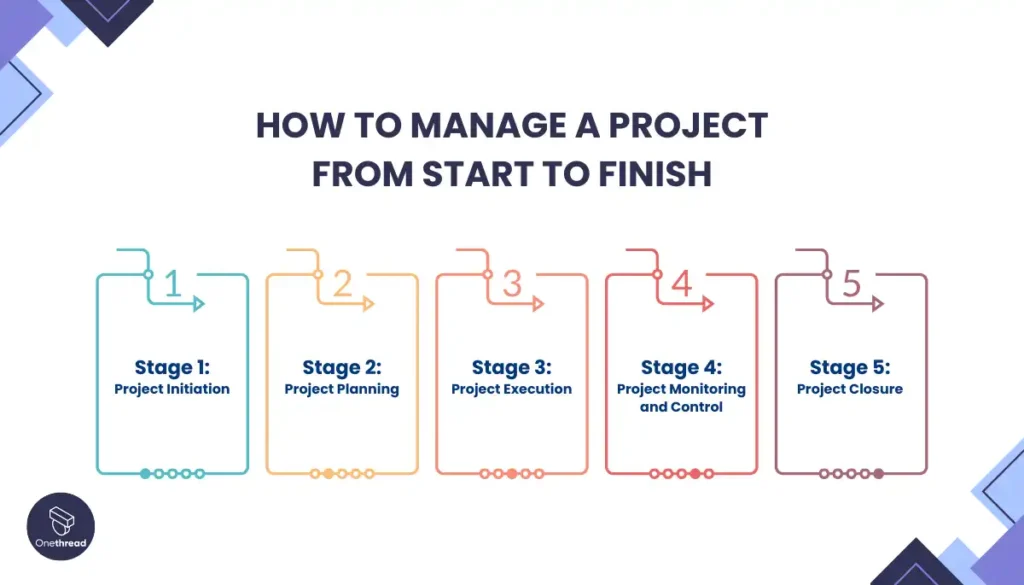
Managing a project effectively requires a structured approach that encompasses 5 crucial stages. Those are:
- Project Initiation
- Project Planning
- Project Execution
- Project Monitoring and Control
- Project Closure
By following a well-defined process for managing a project from start to finish, project managers can ensure successful project completion.
Managing various project aspects effectively involves understanding different topics, from allocation of resources to tax implications for freelance workers. When overseeing projects with independent contractors in your team, tools like the 1099 tax calculator can help simplify managing payouts and ensure compliance with financial requirements. Navigating through diverse project components while maintaining focus on stakeholders’ deliverables calls for meticulous planning.
Stage 1: Project Initiation
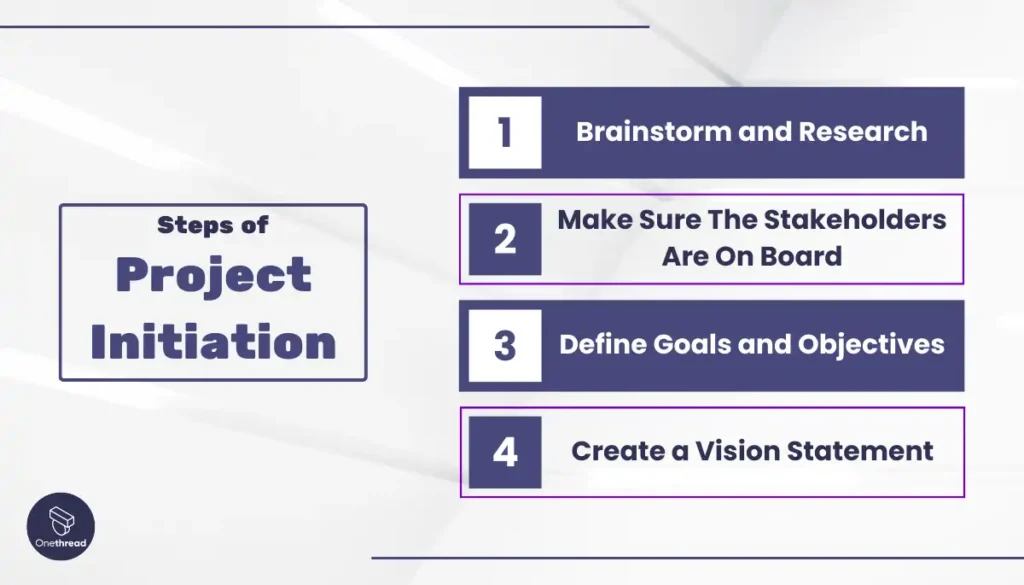
This first step involves defining the project scope and objectives. You identify what needs to happen, why the project is necessary, and how it aligns with larger business goals.
Imagine building a house without a blueprint. You’d be lost in a pile of bricks, wouldn’t you? That’s why the first step in any project is like laying the foundation – it’s all about getting clear on what you’re building and why.
Step 1: Brainstorm and Research
This is your chance to let your imagination run wild! Gather your team, scribble down ideas, and explore all the possibilities. Then, grab your magnifying glass and research the heck out of it.
Is your project feasible? Is there a demand for it? The more informed you are, the better decisions you’ll make later.
Step 2: Make Sure The Stakeholders Are On Board
Think of stakeholders as your project’s cheerleaders. These are the people who believe in your vision and can make your life easier. Identify key individuals or groups who have a vested interest in your project’s success, like your boss, colleagues, or even future customers.
Get them on board early and they’ll become your rockstars, rooting for you every step of the way.
Step 3: Define Goals and Objectives
Where do you want to be at the finish line? This is where you turn your brainstorming into concrete goals and objectives. Think SMART: Specific, Measurable, Achievable, Relevant, and Time-bound.
For example, instead of saying “build a website,” aim for “launch a user-friendly website with 100 daily visitors within 3 months.” Clear goals act like your compass, guiding you in the right direction.
Step 4: Create a Vision Statement
Think of your vision statement as a movie trailer for your project. It’s a short, punchy sentence that captures the essence of what you’re trying to achieve and why it matters.
Think beyond just the tasks and imagine the impact your project will have. This will inspire you and your team, keeping you motivated when the going gets tough.
Stage 2: Project Planning
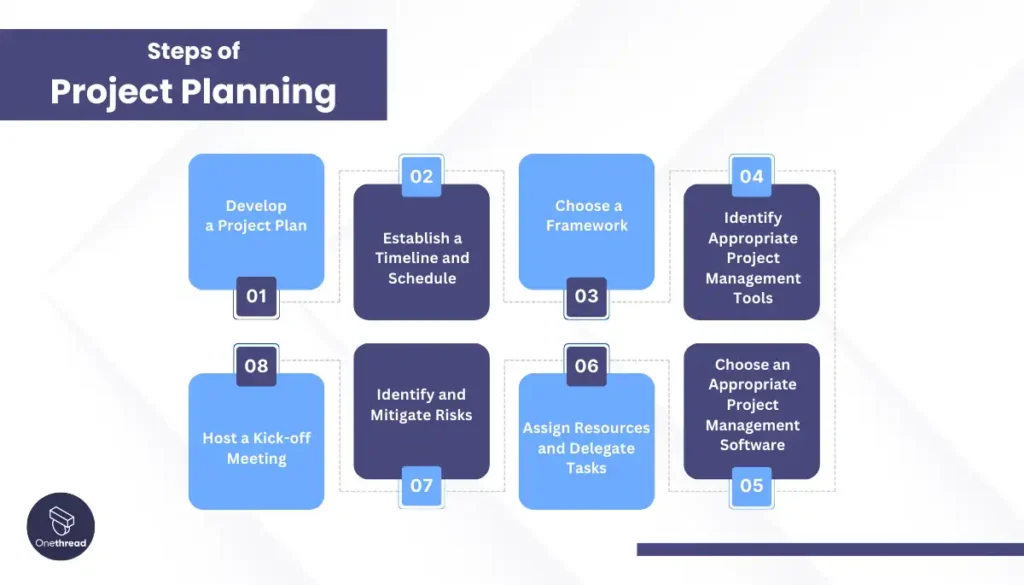
Next, you’ll build a detailed project plan with the schedule, budget, risk analysis, communication strategy, and all other components needed to map out the execution before starting actual work. Careful upfront planning ensures you can manage resources effectively going forward.
Think of it like drawing the blueprints for your dream house – every brick, window, and staircase needs to be accounted for before the construction begins. This stage is where you transform your ideas into a concrete roadmap for success.
Step 1: Develop a Project Plan
This is your project’s battle map, outlining every important step. Break down your goals into smaller, manageable tasks. Assign each task a deadline and estimate the resources needed (think people, tools, and budget!). Don’t forget to consider how tasks depend on each other – if finishing task “A” is crucial for starting “B”, make sure that’s reflected in your plan.
Step 2: Establish a Timeline and Schedule
Imagine a race with checkpoints along the way. That’s what your timeline is! Set realistic deadlines for each task and milestone, taking into account dependencies and potential hiccups. This will keep you on track and ensure everyone knows what’s expected and when.
Step 3: Choose a Framework
There are different project management “frameworks” like Agile, Waterfall, Scrum, etc. each with its own strengths. Choose one that best fits your project’s style and complexity.
Selecting the ideal project management tools and techniques depends heavily on the nature and complexity of your undertaking. Here’s a quick rundown of some popular choices and their ideal project types:
- Kanban:
- Best for: Continuous workflow projects with unpredictable demands (customer support, maintenance tasks).
- Why it works: Visualizes workflow, prioritizes tasks and adapts to changing priorities easily.
- Scrum:
- Best for: Fast-paced, collaborative projects with small, focused teams (software development, product sprints).
- Why it works: Breaks work into short sprints, promoting rapid delivery and iteration.
- Agile:
- Best for: Dynamic, iterative projects with evolving requirements (software development, marketing campaigns).
- Why it works: Adapts to changes quickly, and promotes continuous feedback and improvement.
- Scrumban:
- Best for: Blends the flexibility of Kanban with the planning and structure of Scrum.
- Why it works: Offers a hybrid approach for projects that need both agility and predictability.
- Lean:
- Best for: Eliminating waste and maximizing value in any project type.
- Why it works: Promotes continuous improvement and efficient use of resources.
- Waterfall:
- Best for: Well-defined projects with clear requirements and minimal risk of change (construction, product launches).
- Why it works: Provides a structured approach with predictable phases and milestones.
- Critical Path Method (CPM):
- Best for: Projects with complex dependencies and tight timelines (construction, research projects).
- Why it works: Identifies the critical path of tasks that must be completed on time to avoid delays.
- Critical Chain Project Management (CCPM):
- Best for: Project environments with resource constraints (software development, marketing campaigns).
- Why it works: Focuses on managing resources effectively to optimize project completion time.
- PRINCE2:
- Best for: Large, complex projects with strict governance requirements (government contracts, infrastructure development).
- Why it works: Provides a comprehensive, process-driven framework for managing risks and resources effectively.
- PMBOK® Guide:
- Best for: Establishing best practices and standardizing project management approaches within an organization.
- Why it works: Provides a comprehensive framework for project management knowledge and terminology.
- Six Sigma:
- Best for: Improving process quality and reducing defects in existing operations (manufacturing, healthcare).
- Why it works: Focuses on data-driven analysis and continuous improvement to eliminate waste and errors.
- Extreme Programming (XP):
- Best for: Very short development cycles with high-quality code and rapid feedback (software development).
- Why it works: Emphasizes close collaboration, frequent testing, and continuous improvement.
There’s no one-size-fits-all solution. Consider your project’s unique characteristics, team structure, and risk tolerance when choosing the best framework. Don’t hesitate to combine elements of different approaches to create a customized solution that works for you.
Step 4: Identify Appropriate Project Management Tools
While methodologies provide the framework, project management tools are your trusty tools to build, monitor, and optimize your project. Here are some essential tools that can be used across various methodologies:
Planning and Scheduling:
- Gantt Charts: Visualize tasks, timelines, and dependencies for a clear overview of the project schedule.
- Mind Maps: Brainstorm ideas, organize tasks, and explore connections between different aspects of your project.
- Work Breakdown Structures (WBS): Break down complex projects into smaller, manageable chunks for easier planning and execution.
- Critical Path Analysis: Identify the sequence of tasks that must be completed on time to avoid delays and ensure project success.
Communication and Collaboration:
- Meeting Agendas and Minutes: Ensure focused discussions and track decisions made during meetings.
- Communication Matrix: Define clear communication channels and roles for different stakeholders.
- Collaboration Platforms: Facilitate online communication, document sharing, and task management within your team.
- Kanban Boards: Visualize workflow, track progress, and manage tasks collaboratively in real time.
Monitoring and Control:
- Dashboards and Reports: Track key project metrics, identify trends, and make informed decisions based on data.
- Issue Tracking System: Document and manage project issues, risks, and corrective actions effectively.
- Progress Reports: Communicate project progress, milestones achieved, and any challenges faced by stakeholders.
- Earned Value Management: Monitor project performance by comparing planned value with actual value earned.
Additional Tools:
- Risk Register: Identify, assess, and mitigate potential risks that could impact your project.
- Lessons Learned Log: Document valuable insights and learnings from past projects to improve future endeavors.
- Project Templates: Reuse pre-designed templates for common tasks and documents to save time and effort.
- Checklists and To-Do Lists: Keep track of individual tasks and ensure no crucial steps are missed.
Choose the tools that will help you plan effectively, communicate clearly, monitor progress closely, and ultimately achieve your project goals.
Step 5: Choose an Appropriate Project Management Software
Manual project management just isn’t feasible anymore! Project management (PM) software takes your planning to the next level by:
- Collaborating inter-departmentally: Tag colleagues across teams, share files in the cloud, and keep everyone in the loop with real-time updates.
- Planning sprints and tasks: Create flexible workflows, assign deadlines, and track progress visually with Kanban boards, Gantt charts, and other organizational tools.
- Monitoring work: Gain ultimate visibility into your team’s workload, track individual and team performance, and identify potential roadblocks before they derail your progress.
- Automating routine tasks: Free yourself from tedious administrative work by automating repetitive tasks like sending reminders, generating reports, and managing approvals.
With so many options available, choosing the right PM software can feel overwhelming. Consider your project’s size, complexity, and budget, and explore popular options like:
- Onethread: Streamline your creative workflows with intuitive tools for design, development, and project management.
Try Onethread
Experience Onethread full potential, with all its features unlocked. Sign up now to start your 14-day free trial!
- Wrike: Great for organizing work, assigning tasks, and collaborating across departments.
- Asana: Text-based PM software with Kanban and Gantt layouts for flexible project management.
- Monday: Highly customizable platform with adaptable views and powerful automation features.
- Jira: Ideal for Agile development teams with Kanban boards, sprints, and bug-tracking capabilities.
- ClickUp: All-in-one solution for project management, task management, mind mapping, and communication.
- Smartsheet: Excel on steroids, offering flexible spreadsheets with project management features.
- Trello: A Kanban board-based solution for visualizing workflows and dragging tasks to different stages.
- Zoho Projects: Combines PM with other business-critical tasks like sales, marketing, and finance.
- Teamwork: Project management with built-in client portals for a smooth collaboration experience.
Step 6: Assign Resources and Delegate Tasks
Remember those tasks you mapped out? Now it’s time to find the perfect people to handle them. Play to your team’s strengths and delegate tasks based on their skills and expertise. Don’t be afraid to ask for help! A well-balanced team is a recipe for success.
Key Members of a Project Team:
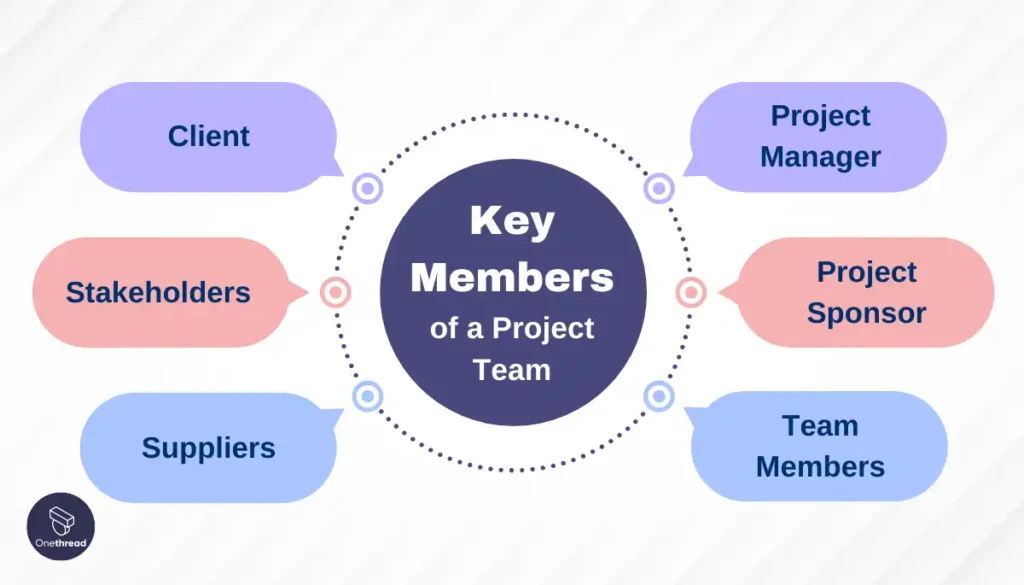
- Project Manager
As the project manager, you are the person overseeing the entire project and holding responsibility for its success.
- Project Sponsor
The project sponsor acts as a senior manager championing the project and working closely with you on key decisions and direction.
- Team Members
The team members are the people who will actively carry out the project tasks under your guidance.
- Suppliers
Suppliers are external partners providing necessary goods or services to facilitate project completion.
- Stakeholders
Stakeholders encompass a wider group with an interest in the project outcomes.
- Primary stakeholders join meetings and play an integral role as active decision-makers influencing the project.
- Secondary stakeholders may attend updates but are not driving key choices.
- Interested stakeholders stay informed on progress but lack strong influence or participation.
- Client
If this is a client-facing project, the client represents the external person or organization receiving the final project deliverables from your team. For internal initiatives, there may not be a specific individual client involved.
Step 7: Identify and Mitigate Risks
Think of potential roadblocks like bumps in the road. Brainstorm any risks that could derail your project, like a tight budget, unexpected technical issues, or even bad weather (if you’re building a snowman, that is!). Then, come up with backup plans to tackle them head-on. Remember, it’s better to be prepared than surprised!
Here are some common risks and problems you might face, along with a brief explanation to help you stay prepared:
Scope Creep:
- What it is: Project scope gradually expands beyond its initial definition, leading to resource overload, missed deadlines, and budget overruns.
- Why it happens: Vague requirements, changing priorities, stakeholder requests, or team enthusiasm can contribute to scope creep.
- How to handle it: Clearly define the project scope upfront, involve stakeholders in decision-making, regularly review and monitor scope changes, and have a formal process for approving scope adjustments.
Poor Communication:
- What it is: Inadequate information flow, lack of transparency, or ineffective communication channels lead to misunderstandings, confusion, and delays.
- Why it happens: Ineffective leadership, siloed teams, unclear roles and responsibilities, or the use of inappropriate communication tools can lead to poor communication.
- How to handle it: Establish clear communication channels, define roles and responsibilities, practice active listening, encourage open and honest communication, and utilize the right tools for different stakeholders.
Financial Setbacks:
- What it is: Unforeseen expenses, budget mismanagement, or lack of funding disrupt project progress and impact deliverables.
- Why it happens: Inaccurate cost estimates, economic fluctuations, poor financial planning, or unexpected changes in scope or resources can lead to financial setbacks.
- How to handle it: Conduct thorough cost estimation, track expenses closely, implement budget control measures, secure alternative funding sources when needed, and communicate challenges to stakeholders transparently.
Resource Constraints:
- What it is: A lack of available personnel, tools, or technical expertise hinders project progress and impacts team performance.
- Why it happens: Underestimating resource needs, poor resource allocation, unexpected staff turnover, or technical dependencies outside your control can create resource constraints.
- How to handle it: Plan resource usage efficiently, prioritize tasks effectively, leverage existing resources creatively, outsource when necessary, and manage stakeholder expectations regarding timelines.
Technical Challenges:
- What it is: Unexpected technical hurdles, integration issues, or software incompatibility can stall project progress and require adaptation.
- Why it happens: Underestimating technical complexity, inadequate testing, lack of contingency plans, or changing technology landscapes can lead to technical challenges.
- How to handle it: Conduct thorough technical feasibility assessments, invest in testing and quality assurance, have backup plans and alternative solutions prepared, and maintain flexibility to adapt to technical surprises.
Team Dynamics:
- What it is: Interpersonal conflicts, lack of team cohesion, or poor morale can derail project progress and create a negative work environment.
- Why it happens: Unclear roles, unhealthy competition, insufficient team building, or lack of leadership can contribute to team dynamics challenges.
- How to handle it: Build a strong team culture, address conflicts constructively, promote collaboration and communication, encourage open feedback, and provide opportunities for team building and support.
Remember, anticipating risks and problems doesn’t mean fearing them. It’s about being prepared to navigate challenges with agility and resilience.
Step 8: Host a Kick-off Meeting
Gather your team and stakeholders for a grand launch party! Introduce your project plan, timeline, and expectations. This is a chance to get everyone excited, answer questions, and make sure everyone’s on the same page. Think of it as a pep rally before the big game – let’s go, team!
Stage 3: Project Execution
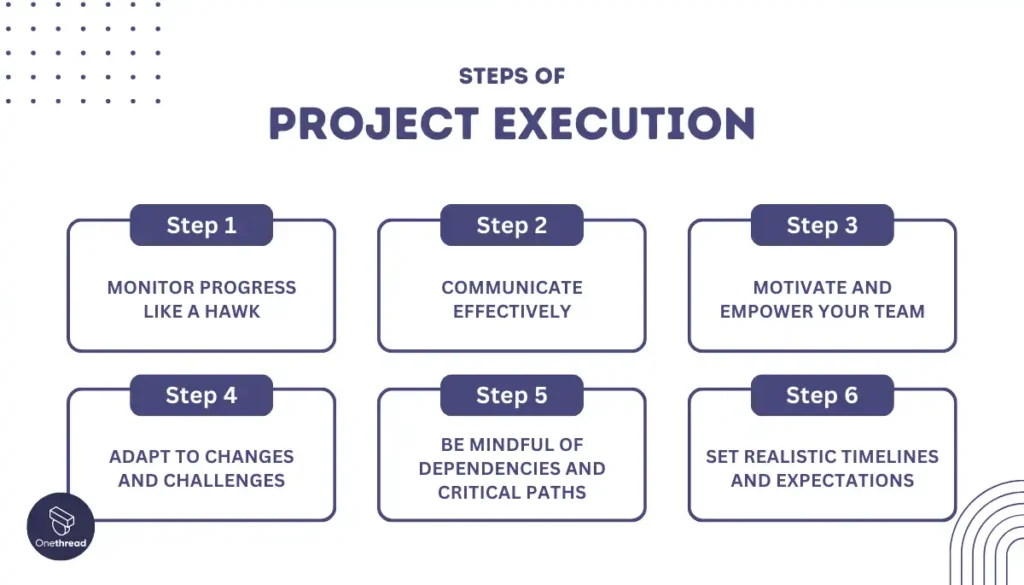
This stage is when the rubber meets the road and your project team gets to work bringing the project plan to life. The team completes project tasks and produces deliverables, while you, as a project manager oversee to make sure progress sticks to the schedule and budget set out in the planning stage.
Step 1: Monitor Progress Like a Hawk
Remember those meticulously planned tasks and deadlines? This is where they come alive. Track progress closely, checking in on tasks and ensuring dependencies are met. Think of it like a conductor watching the orchestra – each instrument needs to be in tune and on time for the symphony to shine.
Step 2: Communicate Effectively
Clear communication is the lifeblood of any project. Share updates regularly, both good and bad, with your team and stakeholders. Remember, everyone’s on the same journey, so transparency builds trust and keeps everyone rowing in the same direction.
Step 3: Motivate and Empower Your Team
Your team is the engine that drives your project. Recognize their efforts, celebrate milestones, and provide support when needed. Foster a collaborative environment where everyone feels valued and heard. Happy teams are productive teams, so let their enthusiasm fuel your project’s success!
Step 4: Adapt to Changes and Challenges
The best-laid plans can get ruffled by unexpected storms. Be prepared to adjust your course as needed. Embrace change as an opportunity to learn and grow, and don’t be afraid to tweak your plan if it means staying on track. Remember, flexibility is key to navigating the ever-changing landscape of projects.
Step 5: Be Mindful of Dependencies and Critical Paths
Think of your project as a complex network of tasks, each one linked to another. Understand how tasks depend on each other and identify critical paths – the sequences that must be completed on time to avoid delays. Being mindful of these connections helps you prioritize effectively and keep the project moving forward.
Step 6: Set Realistic Timelines and Expectations
Don’t try to squeeze a watermelon through a keyhole! Set realistic timelines that consider available resources and potential roadblocks. Remember, over-promising can lead to disappointment. Be honest about what can be achieved within the given timeframe and constraints.
Stage 4: Project Monitoring and Control
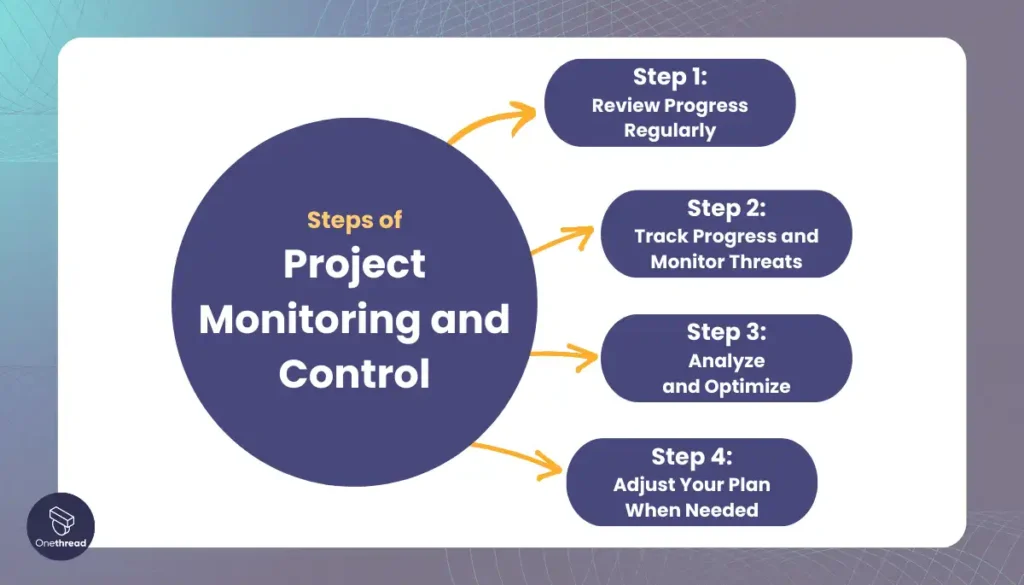
As execution happens, you’ll closely track the status of schedules, budgets, risks/issues, and quality to ensure everything aligns with the plans established and make adjustments if anything goes off track.
This is where you put on your cruise control and ensure your project stays on track, delivering you safely to your destination. Think of it like checking your compass on a hike – make sure you’re heading in the right direction, and adjust your course when needed to avoid getting lost in the wilderness.
Step 1: Review Progress Regularly
Remember that detailed plan you meticulously crafted in Stage 2? It’s time to revisit it! Regularly compare your project’s actual progress against the plan, checking in on deadlines, milestones, and resource usage.
Be proactive in identifying any deviations or delays. Think of it as a pit stop to assess your journey and make sure you’re still on the planned route.
Step 2: Track Progress and Monitor Threats
Just like a vigilant detective, keep your eyes peeled for potential risks and issues. Track progress closely, not just in terms of tasks but also in areas like budget, quality, and stakeholder satisfaction. Proactively identify potential problems before they snowball into bigger issues.
Remember, it’s easier to nip a bud in the beginning than wrestle a full-blown tree later!
Step 3: Analyze and Optimize
Don’t just collect data, dissect it! Analyze performance data like a detective on the case. Look for trends, identify areas for improvement, and uncover opportunities for optimization. This could involve using tools like earned value management or project dashboards to see where resources are being used effectively and where adjustments might be needed.
Note that, data is your friend – use it to fine-tune your project and avoid making costly mistakes.
Step 4: Adjust Your Plan When Needed
Sometimes, even the best-laid plans need a little tweaking. Don’t be afraid to adapt and adjust your plan as needed if circumstances change or roadblocks appear. Remember, clinging to a rigid plan in the face of challenges can lead you to a dead end.
Be flexible, embrace change, and adjust your course to ensure successful project completion. Think of it like re-navigating your route due to unexpected traffic – sometimes, detours can lead to even more scenic adventures!
Stage 5: Project Closure
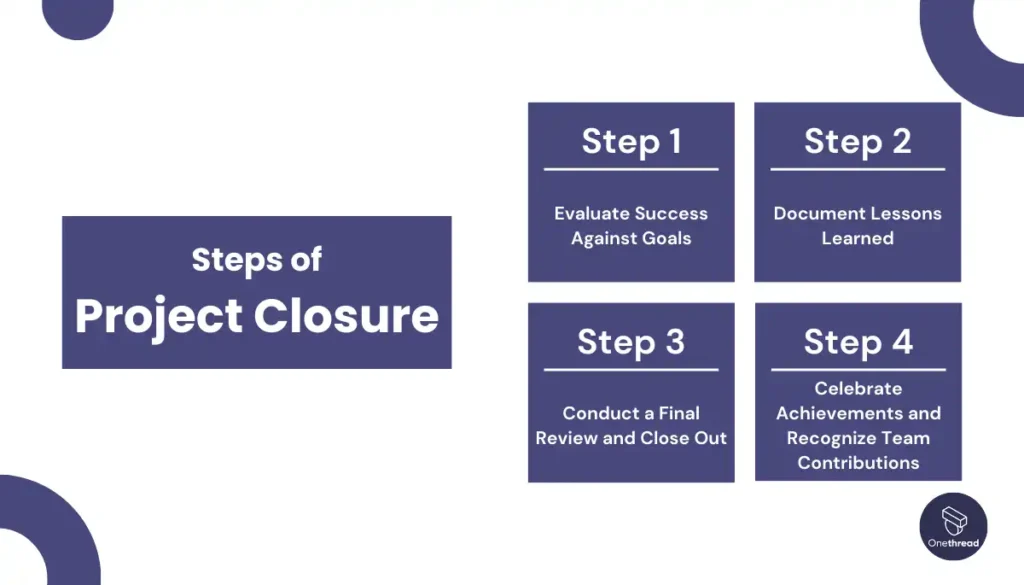
Once all project objectives and scope have been achieved, you’ll formally close out, doing final evaluations of quality, budget, and learnings for future improvement. This critical last step brings the project to an organized end and recognition.
This is where you formally bring your project to a satisfying end, reaping the rewards of your hard work and ensuring the journey wasn’t just the destination. Think of it like popping open a bottle of champagne after a marathon – celebrate the victory, learn from the experience, and prepare for the next exciting race!
Step 1: Evaluate Success Against Goals
Remember those clear goals and objectives you set back in Stage 1? It’s time to compare them to the reality you’ve created. Did you achieve what you set out to do? Did you deliver the promised value?
Take a critical look at the project’s outcomes and evaluate its success objectively. This analysis isn’t about finger-pointing; it’s about learning and improvement.
Step 2: Document Lessons Learned
Every project is a treasure trove of valuable lessons. Don’t let those gems go to waste! Document all the experiences, both good and bad. What worked well? What could have been done differently?
Capture these insights for future projects, creating a knowledge base that can guide and improve your journey. Think of it as planting seeds for future harvests of project success.
As you wrap up your project and conduct a final review, don’t overlook the value of creating a centralized repository of insights. This is where knowledge base software truly shines by organizing learnings that can guide future projects.
Step 3: Conduct a Final Review and Close Out
Like the meticulous accountant you are, ensure all loose ends are tied. Conduct a final review, confirm that all deliverables are complete and up to standard, and close out the project formally.
Inform stakeholders of the completion, provide final reports, and ensure everyone is satisfied with the outcome. Consider putting the official stamp of approval on your masterpiece.
Step 4: Celebrate Achievements and Recognize Team Contributions
A project’s success is never a solo act. It’s a symphony orchestrated by a talented team. Take this opportunity to celebrate their achievements and contributions.
Recognize individual efforts, share the joy of completion, and give your team the applause they deserve. Remember, their dedication and hard work fueled the project’s engine, and they deserve to bask in the glow of victory.
Project closure might seem like the final chapter, but it’s also the beginning of something new. By taking the time to evaluate, learn, close, and celebrate, you ensure a smooth transition and pave the way for future success. So, raise a glass to your team, your achievements, and the lessons learned. The next project awaits, and you’re now equipped with even more tools and wisdom to navigate its exciting journey!
Specific Project Considerations: Managing Different Project Types
Remember those awesome project management tools and tips? Let’s see how they apply to different project types!
How to Manage A Construction Project?
Construction projects have complex dependencies and tight timelines, so using the Critical Path Method (CPM) ensures tasks stay on track. Carefully plan resources and sequencing with Gantt charts. Monitor safety, quality, budgets, and progress closely. Use checklists to ensure regulatory compliance.
- Check out the Best Construction Project Management Software
How to Manage A Research Project?
Research projects are iterative with evolving requirements as new discoveries emerge. Use Agile methods for flexibility, dividing work into focused sprints. Allow for repetition of steps as hypotheses are tested. Documentation is critical – meticulously log progress, data, analysis, and learnings.
How to Manage A Software Project?
Software projects work well with Agile or Scrum approaches that facilitate rapid iteration and continuous testing. Given the iterative nature of software projects, utilizing a retro tool can be highly beneficial.
These tools support regular retrospectives that enhance adaptation and continuous improvement, aligning with Agile principles by fostering an inclusive and engaging environment for feedback and iteration. Use version control systems to manage code changes. Automate builds and testing when possible. Plan sprints in priority order and get user feedback early and often.
- Check out the Best Software Development Project Management Software
How to Manage A Building Project?
See construction project management tips. Ensure permits, safety protocols, and inspections are handled. Create detailed upfront plans mapping dependencies. Use schedules and Gantt charts to coordinate multiple trades. Watch budgets closely as material costs fluctuate.
How to Manage A Design Project?
Design is an iterative process benefiting from Agile principles. Map dependencies between design elements. Use sprints and regular stakeholder reviews to gather feedback and refine designs. Use mind maps and sketches to visualize ideas. Maintain a creative, collaborative environment.
Check out the following project management tools for various design projects:
How to Manage A Consulting Project?
Begin with a clearly scoped statement of work and timeline based on buyer needs. For large engagements, provide status reports to demonstrate progress. Manage client expectations proactively throughout. Conclude with delivered assets per contract and evaluate project success against original goals.
How to Manage A Website Project?
Websites require coordination across design, content, and technology. Use sprints to break down work and gather feedback iteratively. Involve all stakeholders and preview changes often. Conduct user acceptance testing before final approval. Follow a detailed pre-launch checklist covering marketing, analytics, SEO, etc.
9 Effective Project Management Tips for Beginners: Your Project Success Toolkit
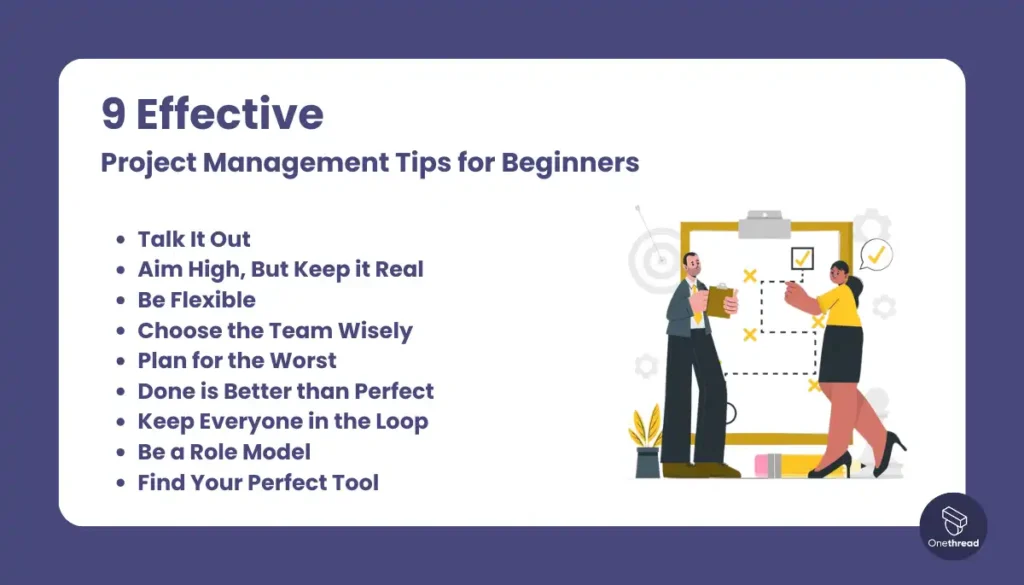
Ready to conquer your project? Let’s break down the secrets to success into simple steps you can use right now:
- Talk It Out: Keep everyone on the same page with clear communication. Chat with your team, explain goals, and listen to feedback. It’s like having a team huddle before building a Lego castle!
- Aim High, But Keep it Real: Set goals that challenge you, but don’t bite off more than you can chew. Be realistic about what you can accomplish with the time and resources you have. Think of it like planning how many Lego bricks you need for your spaceship.
- Be Flexible: Things rarely go exactly as planned. Be flexible and adapt to changes as they come. Think of it like building your Lego castle with different colored bricks if you run out of the original ones!
- Choose the Team Wisely: Surround yourself with skilled and motivated people. Delegate tasks based on strengths, and work together like a dream team. It’s like having awesome co-pilots for your Lego spaceship!
- Plan for the Worst: Don’t let unexpected bumps in the road derail you. Identify potential risks and have backup plans ready. Think of it like having extra Lego pieces in case some break during construction!
- Done is Better than Perfect: Strive for progress over perfection. Sometimes “good enough” is good enough, especially if it keeps you moving forward. Think of it like finishing your Lego castle even if the towers aren’t perfectly symmetrical.
- Keep Everyone in the Loop: Share your progress with stakeholders, get their feedback, and celebrate achievements together. It’s like inviting everyone to admire your awesome Lego creation!
- Be a Role Model: Lead by example! Show your team dedication, positive attitude, and willingness to learn. Think of it like being the captain of your Lego spaceship, inspiring everyone to reach for the stars!
- Find Your Perfect Tool: Choose the right software to manage your project. There are tons of options for tasks, communication, and keeping track of everything. Think of it like finding the coolest tools for building your Lego masterpiece!
What to Look for When Evaluating Project Management Software?
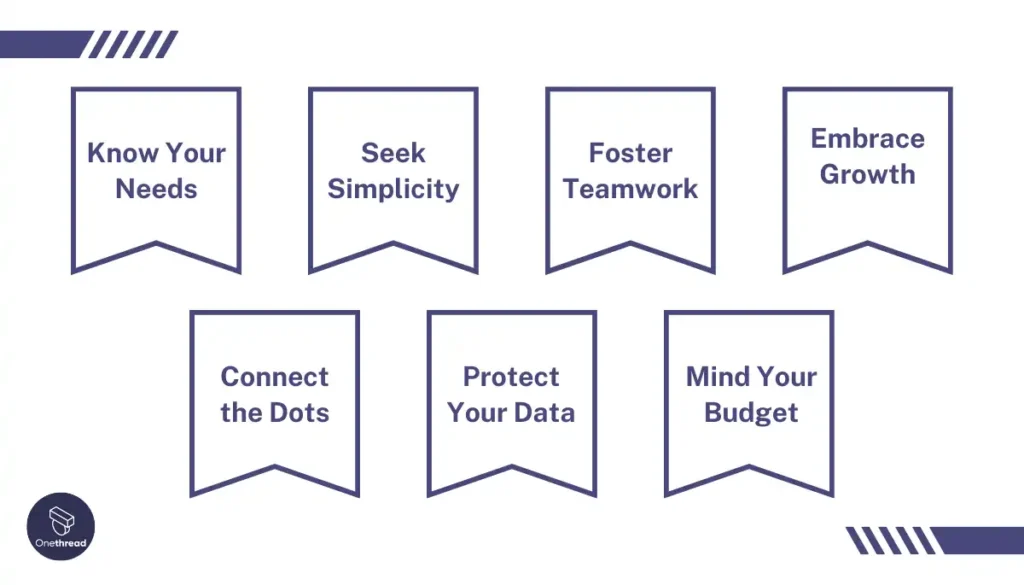
Here’s a guide to navigating the maze of project management software and finding your perfect match:
- Know Your Needs:
- Start with a list of must-have features: Task management, collaboration tools, dashboards, resource management, budgeting, reporting, etc.
- Consider your team’s size and working style: Do you need a simple tool for small teams or a robust platform for large organizations?
- Identify specific needs: Do you require Gantt charts for scheduling? Integrations with other tools? Mobile apps for on-the-go access?
- Seek Simplicity:
- Choose software that’s intuitive and easy to learn: It should save you time, not add to the learning curve.
- Look for a user-friendly interface: Clear navigation, intuitive menus, and simple task assignments make it easier for everyone to adopt.
- Foster Teamwork:
- Prioritize tools that promote collaboration: Messaging, file sharing, shared calendars, and real-time updates keep everyone in sync and boost productivity.
- Look for features that encourage communication and feedback: This builds trust and ensures everyone’s on the same page.
- Embrace Growth:
- Choose software that can grow with your needs: As your team expands or projects become more complex, you’ll want a tool that can adapt seamlessly.
- Consider scalability in terms of users, projects, and storage capacity: This ensures the software can keep pace with your evolving demands.
- Connect the Dots:
- Look for software that integrates with your existing tools: This streamlines workflows and reduces data silos.
- Common integrations include email, calendars, cloud storage, CRM systems, and accounting software: Seamless integration saves time and boosts efficiency.
- Protect Your Data:
- Ensure the software has robust security measures: Encryption, user permissions, and data backup are crucial for protecting sensitive information.
- Prioritize software with a strong reputation for security: This safeguards your projects and builds trust with clients and stakeholders.
- Mind Your Budget:
- Evaluate the cost of the software and its value: Consider features, user count, and long-term benefits.
- Explore free trials or demos to test out options before committing: This helps ensure a good fit for your team and budget.
Effective Project Management with Onethread to Manage Projects
Onethread provides comprehensive tools for managing projects efficiently, covering all five essential project management steps: initiation, planning, execution, monitoring, and closure. Whether you are a project manager or a team member, Onethread offers the necessary features to enhance project management.
Try Onethread
Experience Onethread full potential, with all its features unlocked. Sign up now to start your 14-day free trial!
1. Say goodbye to endless email chains and hello to focused collaboration
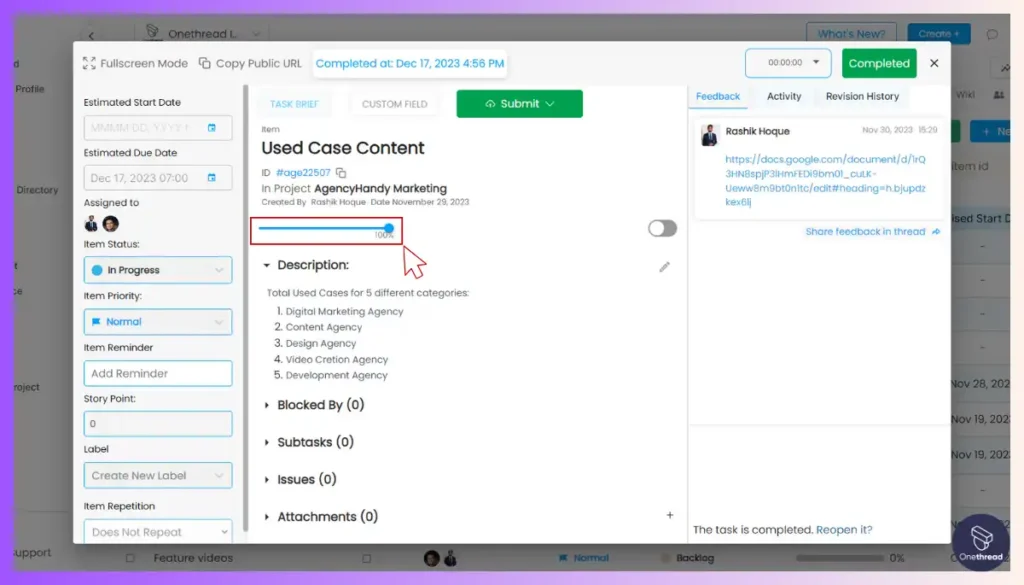
Onethread eliminates the hassle of lengthy email threads so your team can collaborate efficiently. Discuss ideas, share updates, and make decisions seamlessly within Onethread’s centralized platform.
2. Collaborate effortlessly on project plans with online discussions
Onethread takes the guesswork out of project planning with user-friendly tools for outlining project details and tracking progress. Online discussions make it easy to collaborate on project plans. Visualize progress and dependencies with Gantt charts, ensuring everyone stays on track.
Facilitating Project Planning with Online Discussions
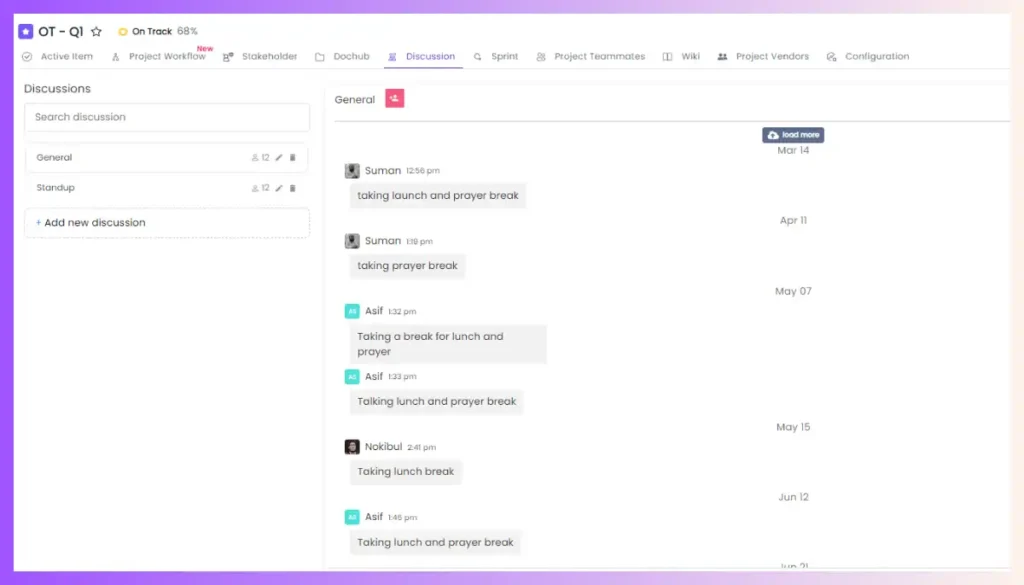
Onethread offers online discussions to brainstorm and collaborate on project ideas. Instead of wasting time on regular meetings, team members can engage in productive discussions to kick-start projects, ensuring that all ideas are heard and considered.
Tracking Project Progress with Gantt Charts
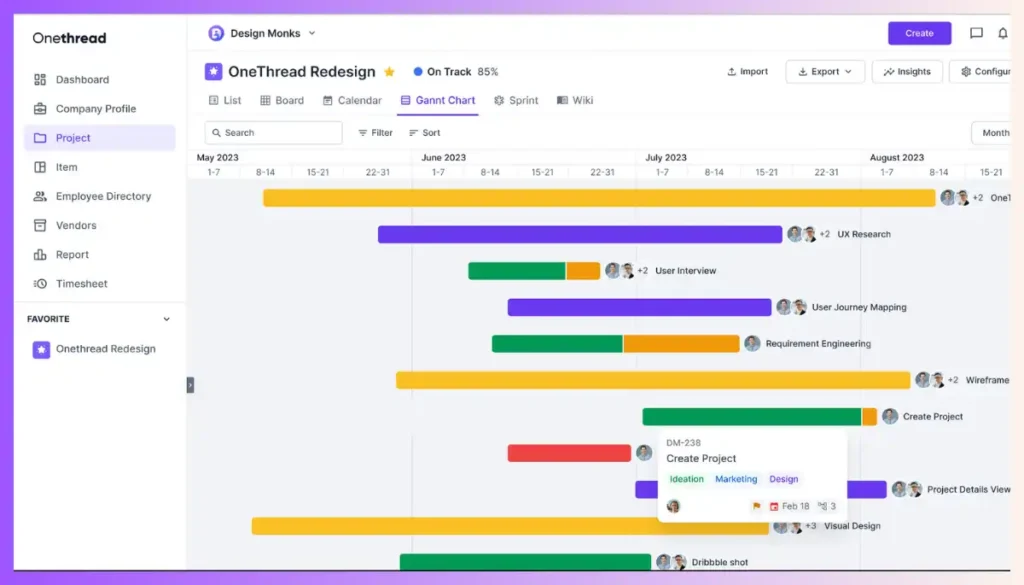
Gantt charts in Onethread provide a clear overview of project progress. You can set task dependencies, track task progress percentages, and view start and end dates for each task. This visual representation helps you plan and allocate resources efficiently, ensuring that projects stay on track.
3. Schedule tasks, assign resources, and manage deadlines with ease
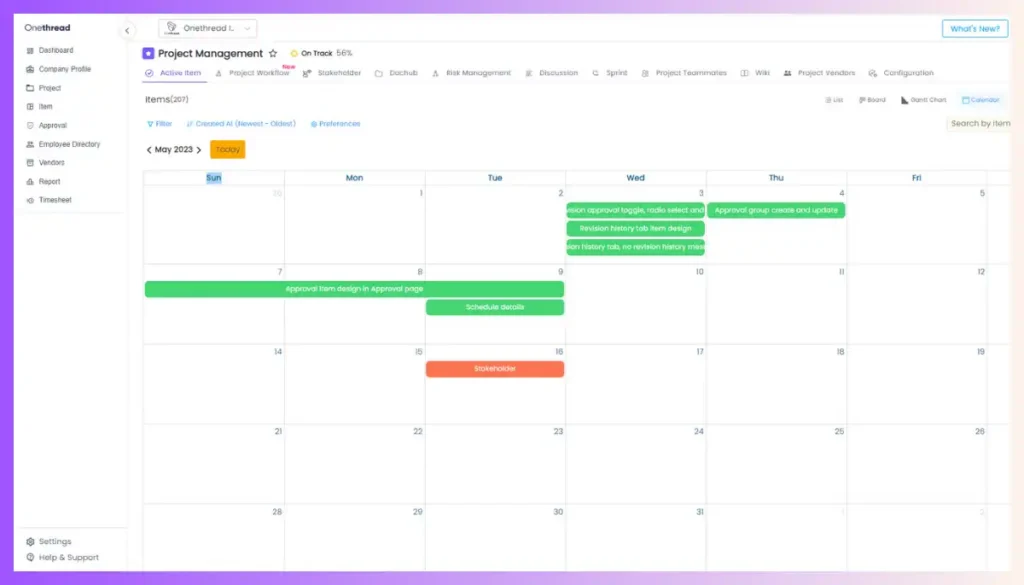
Onethread offers intuitive features for scheduling tasks and organizing work so your team can get more done. Easily schedule tasks, assign resources, and manage deadlines. Optimize workflows and prioritize effectively to achieve goals on time.
4. Align your team around well-defined goals and objectives
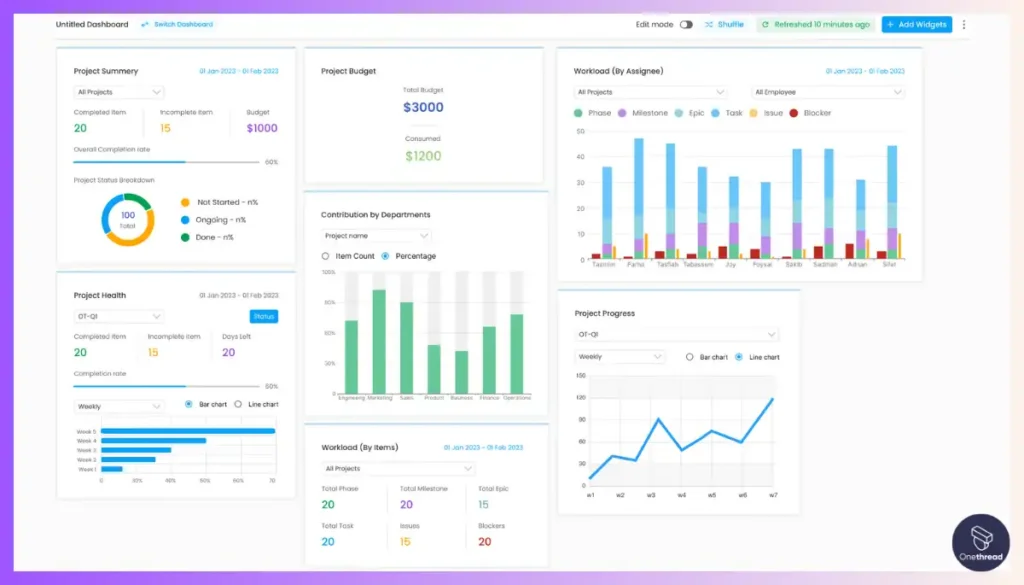
Onethread helps define clear project goals and objectives so everyone understands priorities and can focus on achieving them. Set clear goals and objectives for your team. Ensure everyone understands the project’s purpose and their individual contributions.
5. Foster a connected and engaged workforce with seamless communication tools
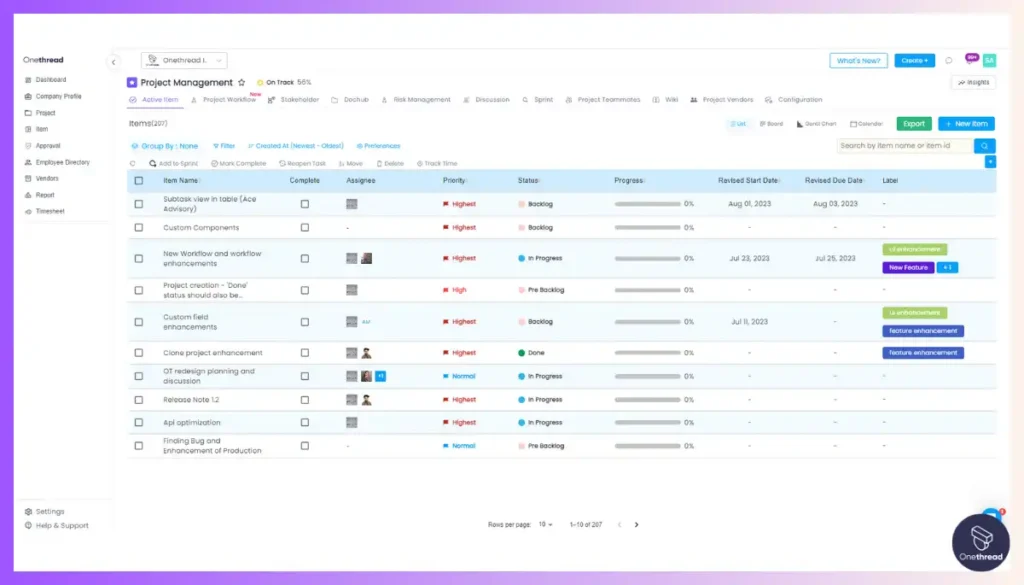
Onethread brings your team together through seamless communication tools to foster collaboration and teamwork. Communicate seamlessly with your workforce to keep them engaged and connected. Break down silos and encourage knowledge sharing for a stronger team dynamic.
6. Identify potential roadblocks early and implement proactive solutions
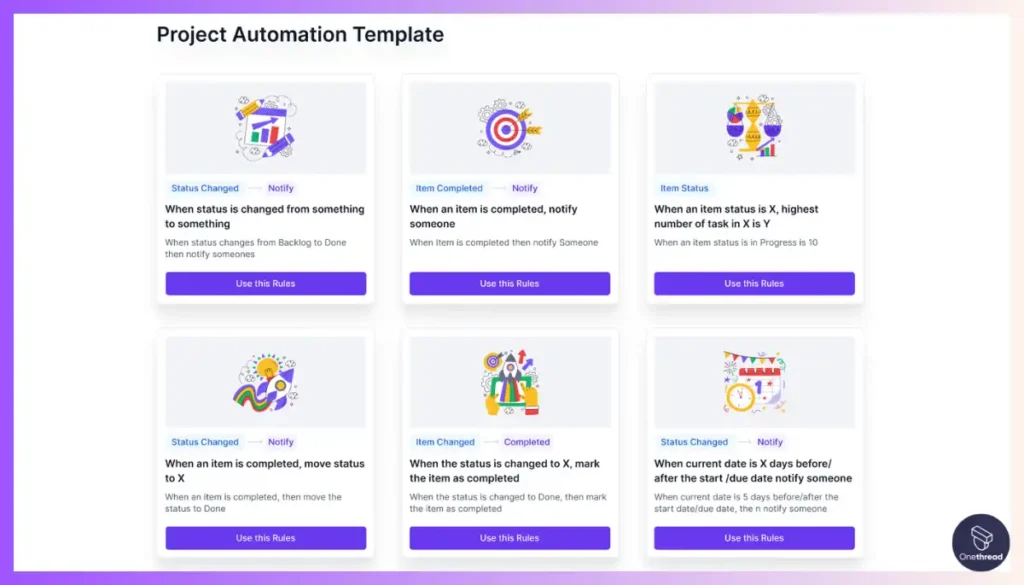
Onethread enables teams to surface potential issues early so projects stay on time and within budget. Implement proactive solutions to potential roadblocks early. Stay ahead of risks and mitigate issues before they derail progress.
7. Organize files and documents effortlessly for easy access and sharing
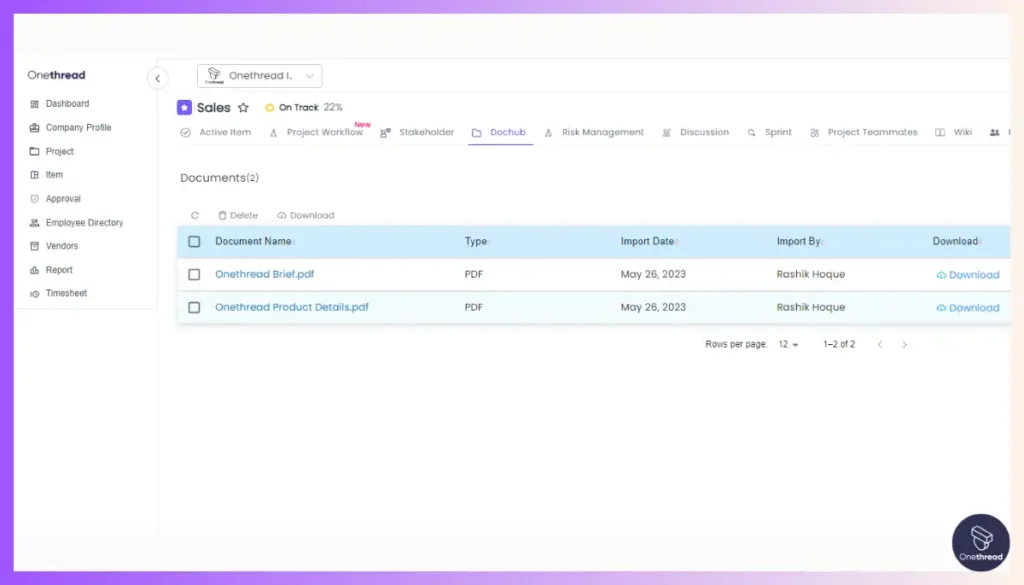
Onethread centralizes files and documents so teams spend less time searching and more time progressing. Access and share files and documents effortlessly. Eliminate time wasted searching for information and keep project knowledge at your fingertips.
8. Track project health and make informed decisions with real-time data and customized reports
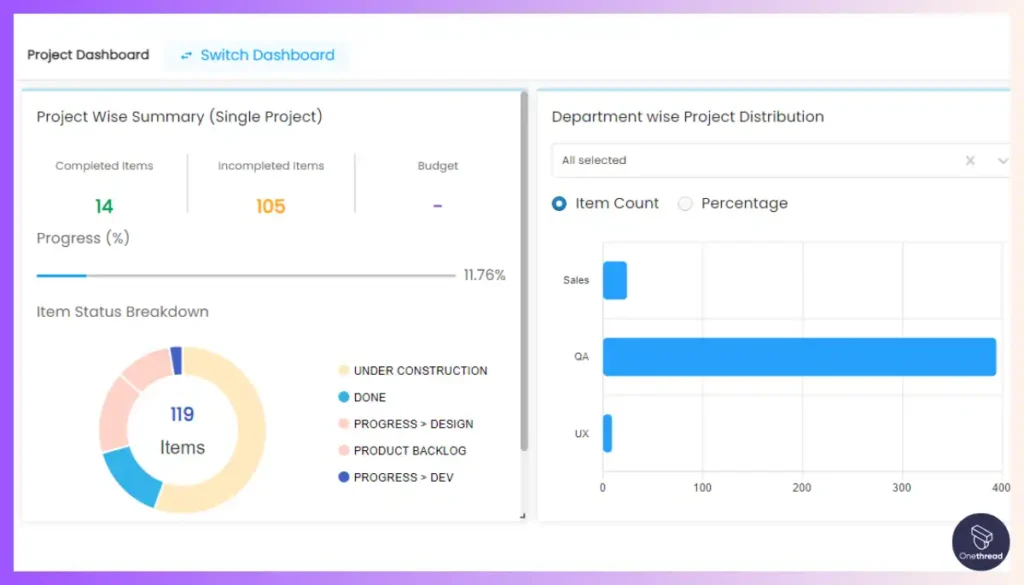
Onethread offers customizable reports and progress tracking so you can monitor performance and make decisions in real-time. Make informed decisions based on real-time data and customized reports. Identify areas for improvement and celebrate successes as they happen.
9. Simplify time tracking and resource allocation for accurate project forecasting
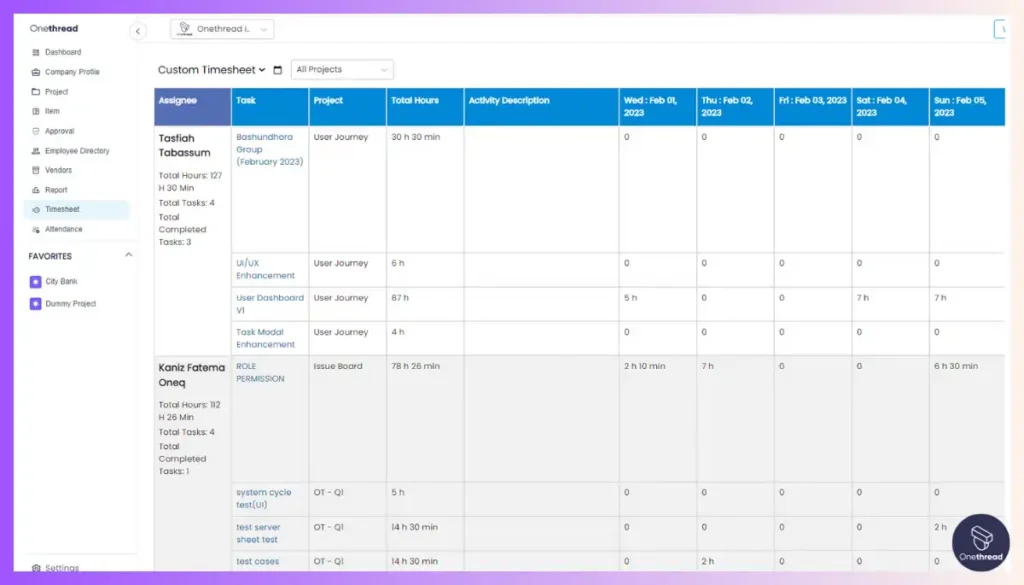
Onethread provides intuitive scheduling tools to help team members organize their time, hit deadlines, and achieve work-life balance.
12. Respond quickly to changes and track task progress with flexibility
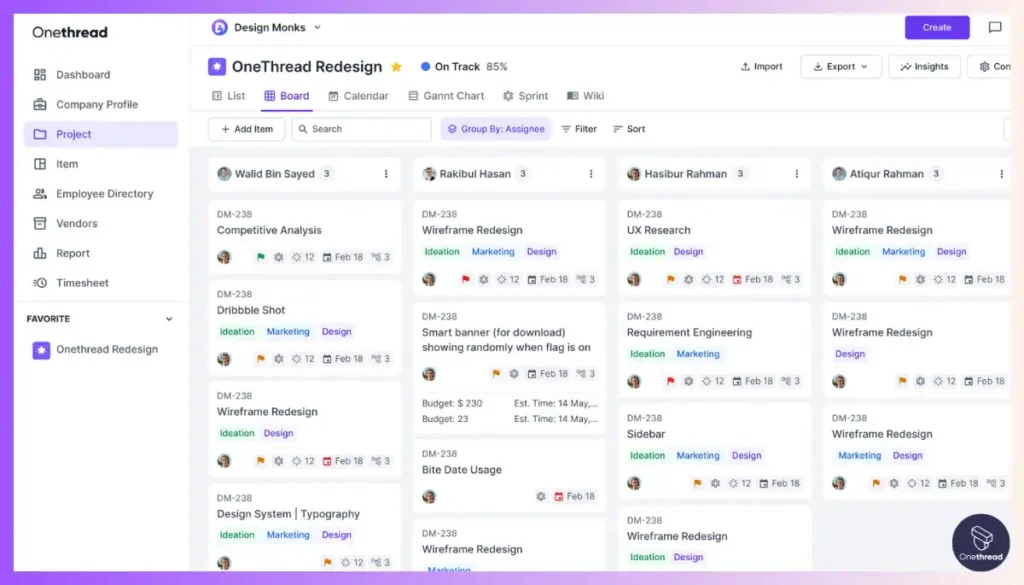
Onethread offers robust task tracking so you can monitor progress toward objectives and motivate your team to push forwards. Track task progress with flexibility and respond quickly to changes. Stay nimble and ensure projects evolve to meet evolving needs.
13. Recognize achievements and milestones to boost team morale and motivation
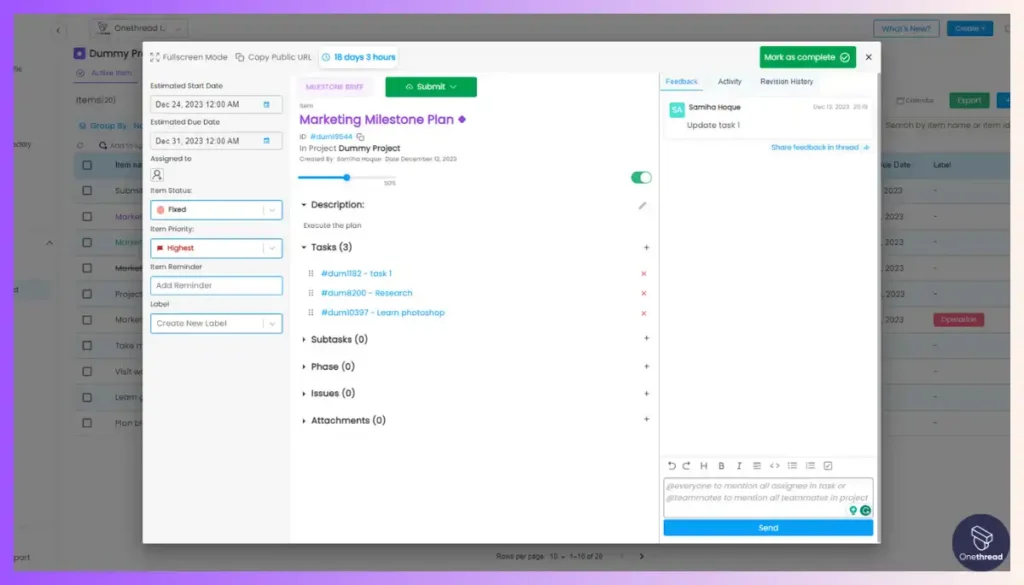
Onethread helps teams acknowledge progress milestones together – fueling momentum and boosting morale. Motivate your team by recognizing milestones and achievements. Foster a culture of appreciation and accomplishment.
14. Keep clients, vendors, and partners informed and engaged throughout the project lifecycle
Onethread enables straightforward communication with clients and vendors so project delivery is smooth from start to finish. Maintain communication with clients, vendors, and partners throughout the project lifecycle. Facilitate seamless collaboration and build stronger external relationships.
Try Onethread
Experience Onethread full potential, with all its features unlocked. Sign up now to start your 14-day free trial!
Benefits of effective project management
Effective project management provides critical planning, oversight, and communication that helps organizations achieve goals on time and on budget. The main benefits include:
- Meeting deadlines and milestones quicker: Careful scheduling and task monitoring ensure projects stay on pace to deliver results without delays. Teams can celebrate successes faster.
- Optimizing budget and resources: Detailed planning prevents wasted spending while allowing for reallocation if new needs arise. Teams aren’t guessing on supplies and can work efficiently.
- Improving quality and outcomes: With every aspect scoped and managed, there is clarity to meet all requirements at the highest standards possible. Teams are empowered for success.
- Simplifying task delegation: Breaking projects into tasks/subtasks with assigned owners clarifies expectations. Less miscommunication means smoother handoffs between interdependencies.
- Building experience for future projects: Documentation during execution captures critical knowledge from challenges and wins. Teams learn what works to replicate it again.
With project management, organizations complete complex initiatives successfully by ensuring disciplined oversight across planning, coordination, budgeting, and delivery. Teams execute reliably on time and on budget when given the structure, insights, and support needed to minimize surprises. This builds confidence in meeting goals consistently with each subsequent project.
FAQs
What are the 5 steps in project management?
The 5 key steps in project management are: 1) Initiating – defining goals and stakeholders; 2) Planning – creating a detailed plan and timeline; 3) Executing – working the plan; 4) Monitoring & Controlling – tracking progress and adjusting as needed; 5) Closing – finishing all activities and assessing outcomes.
What are the 7 steps to successful project planning?
The 7 steps to successful project planning are: 1) Define purpose and scope; 2) Outline objectives and goals; 3) Identify tasks and activities; 4) Estimate time requirements; 5) Assign resources and responsibilities; 6) Construct schedule; 7) Anticipate risks and challenges.
What are the 7 C’s of project management?
The 7 C’s of project management are: 1) Cause – the business case; 2) Community – stakeholders and team; 3) Collaboration – cross-functional cooperation; 4) Communication – clear and consistent; 5) Change – flexibility and openness; 6) Complexity – systems thinking; 7) Creativity – innovation and solutions.
How can I improve my project management skills?
You can improve project management skills by taking classes, earning certifications, reading books/blogs, joining PM networking groups, finding a mentor, volunteering to lead a project, starting small, and asking for feedback often.
How to manage a large project?
Break extremely large projects into more manageable phases or workstreams. Define clear goals/scope for each phase. Use rigorous planning, scheduling, risk management, and Resource Management. Ensure strong governance with portfolio management. Prioritization is key with so many moving parts.
How to manage a project behind schedule?
If a project is behind schedule, hold a meeting to reassess remaining tasks and resources needed, identify obstacles, consider what can be delayed or removed, add/outsource resources if necessary, communicate changes, revise the schedule, track daily progress, work overtime if budget allows, and request deadline extension if still unachievable.
How to manage a project you know nothing about?
Admit knowledge gaps openly, study basics through books/online resources, gather background from documents, ask questions and listen to the team, find an expert mentor, allow more time for discoveries along the way, establish sound structures/plans but expect to refine when learning more, focus on facilitating team versus directing content.
How to manage a project with limited resources?
With limited resources, be clear on priorities and scope down if needed, explore the creative use of existing resources, borrow resources from other projects if available, make timeline adjustments to work sequentially versus concurrently if helpful, outsource selectively, track progress rigorously, motivate and leverage strengths of the team.
Conclusion
Managing projects requires careful planning, effective communication, efficient resource allocation, and strong problem-solving skills. It is a dynamic process that requires adaptability and flexibility as circumstances may change throughout a project.
By following these strategies and incorporating them into your project management approach, you can increase your chances of success and achieve your desired outcomes efficiently.
Streamline manage projects with Onethread: collaborate, track progress, and meet deadlines effortlessly. Experience seamless integration, real-time updates, and advanced task management features. Boost productivity and achieve success. Try Onethread today!
Try Onethread
Experience Onethread full potential, with all its features unlocked. Sign up now to start your 14-day free trial!
